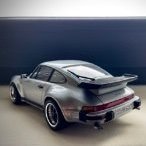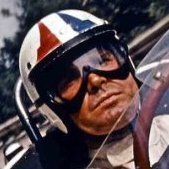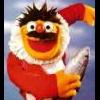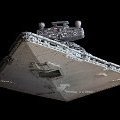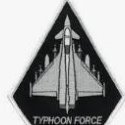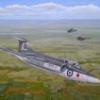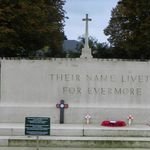Search the Community
Showing results for tags 'revell'.
-
To celebrate its 50th birthday,Lufthabsa painted one of their A321s in this very attractive retro livery. Revell was of course to the service and provided a reissue of their A321 kit with the retro decal set. They even served both modelling fractions,those who want window decals and those who like open windows,by providing 2 sets of cheatlines. I went for the open window version,I only had to use a decal for the cockpit as I cracked the clear part while installing it. The build is straight forward,everything fits nicely. For the paints,a mix of Revell enamels,Testors and Gunze was used. The underbelly is a mix of Revell aluminium with Revell grey 374. Its a bit tricky to get it right. Revell tells you to paint it entirely aluminium but as the Airbus is more compisite material than metal,its completely wrong. The decals fit very well,only around the nose a few touch ups are required. Another airliner with a special livery can ve added to the collection.😊 Thanks for looking Alex
-
Another great release from Revell is the A321 in the special livery of Austrian Airlines,celebrating the 1000th anniversary of the Austrian republic in 1996. The A321 wears the faces of the most iconic persons of Austria from the past to present (1996) The kit is well known and needs no further introduction. The highlight of the kit is clearly the decal set,which is top quality and fits on the kit like a treat. Painting is straight forward,all white fuselage (Gunze primer 1500) The wings are painted with Testors aircraft grey mixed with white,corogard panels are Revell 374 grey mixed with a few drops aluminium. The cockpit window is a decal from a PAS decal set,the cabin windows and all the rest are from the kit. Thanks for looking Alex
-
Another one of Revell's "Special Liveries". The Wiener Philharmoniker A340-300. Its a real eye catcher and the kit was frequently reviewed upon its release but its hardly seen built. I wonder why... The most difficult part of the build is the paintjob,esp. the blue belly and the bright blue on the engines. To find the correct demarcation line on the belly is a bit iffy. The instructions are absolutely no help,so intense research on the net is required. The light blue for the engines need to be mixed. I used Revell white 04 and skyblue 52 . The belly blue needs to be mixed as well skyblue 52 with a few drops white 04,here one can use the decal set as a matching pattern. Once this is achieved,the most complicated part is done. The decals are superbly printed and fit wonderful. The only downside to them are that there are no windowholes or windows printed on. I decided to have clear windows,so after application and clear coating,every window was cut out with a new sharp blade.To find all of the windows was time consuming. Then from another decal set,the silver frames were applied and clear coated as,well. The end result is one of the most spectacular liveries ever worn by a A340. As with the other A340s,I also corrected and enhanced the engines. Thanks for looking Alex
-
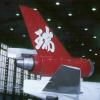
Airbus A330-300 Demonstrator Revell 1/144
Alex1978 posted a topic in Ready for Inspection - Aircraft
Revell's first release of their A330-300 was back in 1993 with the Demonstrator markings. I still had them in my stash since childhood.As I had 4 A330s ,I decided to use that set on one of them since they still looked usable. I should be proven otherwise.... They were very stiff,brittle and showed no response to any decal softener.Applying them was a real pain in the a... After clear coating them 3 times with Future,they finally stayed on the model but I was not too happy with the result. In the end,I painstakingly hand brushed the blue on each decal with Revell 54 blue to enhance the shine and overall quality,then clear coated it again with Future. It looks a lot better than before. The white is Gunze primer 1500. Thanks for looking Alex -
This is the original Revell boxing with the colourful Aer Lingus decals. The kit is now quite hard to find and on some well known sites sold for astronomic prices. I had it in my stash for many years but cant remember where I got it from. As I went through my A330/A340 serial build,this was build simultaneously with the others. Despite its age,the kit is very nicely detailed and the decal set is superb as well. Lots of details and very nicely printed.If I remember correctly,it was done by NAZCA. The top of the fuselage was painted with Revell emerald green,unfortunately the pictures show it much darker as it really is. The white is my well proven Gunze primer 1500. Aer Lingus has/had obe of the most attractive liveries,so this is a nice addition to my Airbus fleet. Thanks for looking Alex
-
Another conversion,this time a A330-200 in LTU livery. I had the LTU issue of the Revell A330-300 in my stash but I wanted to do the -200. Some years ago I bought the BRAZ resin fin and tailplanes for the A330-200 so while I was already hacking up the A340 I made the conversion on the A330 as well. Same procedure as with the A340,both types have the same measurements. Paints are Gunze white primer 1500 for the white parts and Revell red 31. Instead of using the red stripe provided on the Revell decal,I airbrushed everything,which gives better results and saves cutting down the decals.Only the letters and logos,doors and letters for the registration are from the decal set.The rest comes from the spares box and other Airbus A330/340 kits. While researching the type,I came across a pic with one of those Airbuses having a white radome.Hence I took that up as well. Thanks for looking Alex
-
A bit later than expected,more of my finished builds since 2022. I had a rather busy schedule in modelling,so a large number of kits got finished.Most of them are now ready to be shown here,some others are still missing a few parts. On we go with the Revell A340. Back in november 1992,Lufthansa presented their first A340-200 in Zurich. I was on there and also was able to take some pics. My camera back then was not the best,I was still a kid,so my parents didnt spend too much on a camera.Hence the pics are not that good,but I still have them. I played with the idea for a long time,shortening the Revell A340-300 down to a -200 and build the first LH A340. The decal set from Revell even has the correct registration for the type. Lack of skill stopped me from doing such a task for many years but last year I thought I was ready for it and gave it a go. While at it,I also took the opportunity to improve the kits engines by adding the vortex generators and rework the inner engines,so they sit higher.The engine mounts of the kit are too large,so if not corrected,they will hang too low. Shortening the fuselage was not that difficult.Some diagrams and pictures found on the www ,showed where to make the cuts. After all was set and ready,reassambly began. Some filling and sanding was required at the fuselage but nothing too distracting,so the paintjob could start. Painted with Gunze and Revell enamels. The grey for the belly and the wings is a mix of Revell 374 with a few drops Revell white 04. The white for the fuselage is Gunze Primer 1500,clear coated with Future. The decals come from the original Lufthansa boxing.Luckily I had a few decal sets ,so I could use bits and parts from the other sheets as one of them was quite yellow and brittle. Some details come from the spares box and other Revell A330/340 kits. It took 30+ years from the idea to the finished product,so I am very happy to finally have this Airbus in my collection. Thanks for looking Alex
-
Unimog 404S (03348) 1:35 Carrera Revell Unimog was the brand-name used by Mercedes for their truck, tractor and commercial vehicle range that began post WWII as an agricultural brand, initially built by another company for them whilst using their engines. The range broadened in the late 40s and early 50s to include trucks, of which the 404 series was one, entering production in 1955. It is a small (1.5 tonne) 4x4 truck that was driven by a 2.2 litre M180 straight-6 Mercedes engine and has impressive off-road performance due to a change that had been required by a customer, the French Army, who wanted the spare tyre to be stored clear of the load compartment. The designers altered the shape of the rear chassis rails to allow the wheel to sit under the floor, the downward sweep giving the chassis extra flexibility that smoothed the ride on rough surfaces, assisted by coil springs, rather than traditional leaf springs. The four-wheel drive system could be disengaged on smoother ground, leaving just the rear wheels engaged, thereby saving fuel and wear on the front drive-shafts, and generally improving performance all round. The 404 series was the most numerous of the Unimog line, and was available as a short or long-wheelbase chassis, with the shorter option phased out at the beginning of the 70s, while the longer wheelbase continued on in service for another decade before it too was retired. The nascent West German Bundeswehr were a major customer, buying substantial quantities of the 404S as a workhorse for their forces, taking on many roles in their service. A total of over 62,000 of the 404S were made over its lengthy production run, with many of them still on and off the roads to this day due to their rugged engineering. The Kit This is a reboxing of the recent tooling from ICM of this Bundeswehr pillar of their transport arm. It arrives in an end-opening box, and inside are five sprues of grey styrene, a small clear sprue, five flexible black tyres, a small decal sheet and a colour printed instruction booklet with decal profiles on the rear pages. Detail is excellent throughout, and includes a full chassis and engine, plus the bodywork and load area, all crisply moulded as we’ve come to expect from ICM. The grille of the vehicle is especially crisp, as are the coil springs on each corner, and the wheels are very well-done with multi-part hubs. Construction begins with the ladder chassis, which is joined together with a series of cylindrical cross-members, plus front and rear beams, the latter braced by diagonal stiffeners to strengthen the area around the towing eye at the rear. The suspension is next, adding an insert to the opposite side of each spring to avoid sink-marks, but care must be taken to align them neatly to minimise clean-up afterwards. Triangular supports for the fuel tanks are added on each side, then attention turns to the six-cylinder Mercedes motor. Beginning with the two-part cylinder block and gearbox, the basic structure is augmented by ancillaries, fan, pulleys and drive-shaft for the front wheels, after which the engine is mated to the chassis and has the long exhaust system installed, adding a muffler insert around the half-way point, and siting another drive-shaft adjacent. Two stamped fuel tanks are each made from two parts, with the forward one having a filler tube and cap glued to the side, sitting on the out-riggers that were fitted to the chassis earlier. The front axle is made up from five parts to capture the complex shape of the assembly, to be installed between the suspension mounts and mated to the forward drive-shaft, plus the stub axles for the front wheels. Two stowage boxes are made for the opposite side of the chassis from the fuel tanks, then the rear axle is made up with similar detail and part count, fitting between the suspension and having larger circular stub-axles that have the drum brakes moulded-in. The front wheels have separate drum brakes, and both front and rear axles are braced with damping struts, while the front axle has a steering arm linking the two wheels together, with more parts linking that to the steering column. With the chassis inverted, the front bumper and its sump guard are fixed to the front, and a curved plaque on the rear cross-member, plus another pair of diagonal bracing struts for the rear axles. Each wheel is made up from a two-part hub that goes together much like a real steel hub, but without the welding, around the flexible black tyres. The front and rear hubs are of different design, so take care inserting them in the correct location. Lastly, the chassis is completed by adding the radiator and its frame at the front of the vehicle. The cab is the first section of the bodywork to be made, starting with the floor, with foot pedals, shaped metalwork around the gearbox cut-out, sidewalls and the internal wheel wells below the floor level. A number of additional parts are glued beneath the floor for later mounting, then the lower cab is built up on the floor, including the front with recessed headlight reflectors; bonnet surround, dashboard with decal, plus various trim panels. The floor is then lowered onto the chassis with several arrows showing where it should meet with the floor, taking care with the radiator. Once in place, the bonnet and more interior trim as installed along with a bunch of stalks between where the seats will be inserted. The seats are made from the basic frame to which the two cushions are fixed, much like the real thing, then mounted inside the cab, followed closely by the two crew doors, which have handles on both sides, and pockets in the interior. They can of course be posed open or closed and there is no glazing to put in, thanks to the cabriolet top. More grab-handles, controls and other small parts are fixed around the dash, and the windscreen with two glazing panels are put in place, with a highly detailed steering wheel that has the individual finger ‘bumps’ on the underside, and for your ease, it’s probably better to put the wheel in before the windscreen is fixed in place. The cab is finished off by adding the cabrio top, which starts with an L-shaped top and rear, to which a small rectangular window and two side sections are added, dropped over the cab when the glue is dry and the seams have been dealt with. The load bed begins with a flat rectangular floor that has engraved planking, plus two longitudinal supports and three lateral beams that takes the weight of the bed once complete. The sides of the load area are stamped with raised and recessed detail, and comprise four parts, one for each side, plus raised side framework, and what looks like a spoiler on two short upstands at the front of the load area. Underneath is a rack for a nicely detailed jerry can, a stowage box or three, and the spare wheel on a dropped C-shaped mount, built in the same manner as the road wheels. The number plate holder is hung under the rear, also holding the rear lights for that side, with another less substantial part on the opposite side. The cab wasn’t quite finished earlier, as the front doesn’t yet have lights. The recessed headlight reflectors should be painted with the brightest metallic you can find before they are covered by the clear lenses and their protective cages, joined slightly outboard by combined side-light/indicator lenses, a choice of two styles of door mirrors, and a pair of windscreen wipers to keep the screen clear. Markings You might guess that most of the decal options are green that is so typical of how I remember the Unimog in West German service. From the box you can build one of these two: Kompanie/PzBH24, Braunschweig, 1961 Kompanie/PzGrenBH82, Lüneburg, 1975 Decals are by Cartograf, which is a guarantee of good registration, sharpness and colour density, with a thin matt carrier film cut close to the printed areas. Conclusion The Unimogs were ubiquitous in Cold War West German army service, so there ought to be a good market for a modern tooling of the type, with many variants out there, and more in due course. Highly recommended. Carrera Revell model kits are available from all good toy and model retailers. For further information visit or
-
So this one was a real struggle and the end result is not really what I hoped for. Managed to loose one of the winglets but found one in an unstarted A320 box. I messed up the markings on the horizontal stabilisers, putting the markings on the bottom side after painting and before mounting. Whilst trying to mount them I broke the locator tabs, both of them! Super glued them on and the right one managed to fall down at least 4 times. Paint was a bit messy, not sure why, maybe too much dust in my appartement... Decals from 26 Decals, lovely as usual but still I was able to screw some things up causing me to get a second set. Anyway, I mostly build aircraft I actually have seen/photographed and this one I saw early July in Funchal, Madeira and I made this photo: And then the finished model: Hope the next one on the bench comes out a bit better - Peter
-
The Revell etype is now finished. I made a small WIP thread with some WIP photos also if anyone is interested. Painted in Ammo Mig polished metal and clear coated with Mr. Super Clear. Interior painted in Mr Hobby Russett. Silver/red in my opinion is a colour scheme that always comes out well. It’s a new tooled kit so everything fitted well for the most part. Plenty of details out of the box for the engine bay and a lot of decals to dress it all up. Recommend this kit for anyone else wanting to build a 60’s classic.
-
My just completed car kit, a diversion from the usual aircraft with the challenge of a gloss finish. No clear coat, just polishing. Quite nice details and definitely recommend it. Only the side windows cut out as a deviation from the instructions. My knowledge of Porsches and the 911 was pretty much zero before this build.
-
Hi, Here are some WIP pictures from the etype I'm building at the moment. It is actually near completion but I thought I would put the WIP photos separate from when I upload the finished kit. A great kit, with a lot of parts and decals and it fits together really nice. I went for Ammo Mig polished metal and clear coated with Mr Clear glossy. Interior was painted in Mr Hobby Russet. Some of the potential problems I found are the chrome pieces which are actually a bit fragile, i broke the rear view mirror support piece just by handling it. I also broke one of the rear bumpers in half although it was superglued when i pulled it off because it didn't fit right. Only fit problem I really had was the dashboard, I had to sand down the pedal attachment which goes on the back of it so it could click into place. These are niggling problems however, overall goes together very well generally. Apologies if some of these pictures are not showing the right way, I think the image hosting is setting them all in one fixed ratio.
-
Hi all, I finished this lovely 1/48 O-2A Skymaster last night. It's the ICM kit, from a Revell box. I used AOA Decals, a Yahu instrument panel, Aerocraft Models landing gear legs and New Ware masks for the clear parts. Painted with MRP. Not much to complain about with this kit. Enough detail OOB, and mostly excellent fit. Just two pics this time, as it's not terribly interesting from the rear quarters. Thanks for watching, Pete
-
Imperial Shuttle Tydirium (05657) 1:106 Carrera Revell Star Wars. If you’ve never heard of it, you must have been stuck behind a wardrobe for the last 40 plus years, so go and catch up while we all roll our eyes at you. The original trilogy of films was a ground-breaking trio of films that combined fun story-telling with leading-edge special effects, and most importantly, a great range of characters on both sides of the good/bad divide. By the time the third film of the trilogy, Return of the Jedi reached the screen, the marketing machine was well-and-truly up and running, and many new ships and characters were shown on screen for the first time. One such ship was the shuttle Tydirium, a Lambda-class T-4a shuttle that was stolen from the Empire by some enterprising and brave scallywags, to be used to breach the security at the perimeter of the exclusion zone around the planet Endor, where the new-and-improved Death Star 2.0 was being built. The immortal words “It’s an older code, but it checks out” were uttered, and Chewie ‘flew casually’ down to Endor to commence their operation to destroy the shield generator that was confusingly installed on the planet, protecting a fully operational battle-station that would have presumably had its own shield generators like the first one did before they had to claim on the warranty. Anyway, it’s best not to think too hard about any of the Star Wars stories, and just enjoy them for the fun, innocent hokum that they are, or were. Another shuttle was seen landing, or taking off from a platform as Luke hands himself over to his dad’s tender mercies, showing off its folding wings as it does – a series of design cues that have been continued in other similar shuttles and ships in the Star Wars universe. The Kit This is a re-release of a kit that was first tooled in 2006, and is quite a bit smaller than the original kit from another manufacturer that appeared around the time of the film’s original release. It is moulded in a peculiar scale of 1:106, as has been Revell’s habit for many of their Star Wars offerings, and this kit was initially an EasyKit, with push-fit location turrets and pegs still visible on the insides of the parts. The kit arrives in a shallow end-opening box with the usual black theme and all the standard Star Wars logos, plus a badge that marks this as a 40th Anniversary of Return of the Jedi (RoJ) release. Inside are eight sprues in a chewing-gum white styrene that could be left unpainted by a novice to depict that off-white shade that is typical of original trilogy ships, a clear sprue containing the windscreen, and in my example at least, two sprues of vinyl crew figures consisting of a Stormtrooper and Imperial Officer figure in seated positions. A decal sheet and instruction booklet complete the model side of thing, but there are also six thumb-pots of acrylic paint in various shades from white through various greys to black in the box, plus a #2 paint brush and a small bottle of Revell Contacta Professional model glue, with a fine applicator for precision gluing. I made the mistake of dropping the black pot of paint, which caused the lid to come adrift briefly due to the impact, scattering a small amount of thick paint everywhere. We all know that a little liquid goes a long way, so don’t do that. Detail is pretty good considering the model’s original intent, and apart from the windscreen being transparent rather than darkened, it looks like a Lambda Class shuttle, although there is some conjecture about the size and shape of the “head” of the shuttle, as the model and the full-size studio replica had differing dimensions for whatever reasons, and that has been picked up upon by the purists. This boxing includes a poster that is rolled up into a narrow tube within the box and held in place by an elastic band, which left the poster rather curled up. Rather than show a photo of an extremely curled up poster, we refer you to the photo on the front of the box, which shows many of the main characters in front of an exploding Death Star that has the logo beneath the faces, and “Return to a Galaxy Far Far Away” at the top of the poster in a non-canon serif font. Construction begins with the vertical fin, which is in two halves and the instructions would have you paint the inner lips of the halves black, which is at variance with any photos of the filming miniatures, and is probably to hide the fact that there are no greeblies (small and meaningless details) moulded into the recess between the skins, so whether you do this or stick some tiny bits of styrene into the space to detail it, is entirely up to you. The exterior has raised panels that can be painted a darker grey, or you could use the decals that are provided instead. The same process happens with the wings, although these have no gaps between the skins, so no black paint is needed. The wings are cranked, and at the forward root there is a blaster in a hemispherical turret, one gun per side of the wing, making up a pair. Each wing has a pair push-fitted through a hole, and they should remain mobile if paint or glue doesn’t intervene. The lower hull is a flat panel with curved sides that also has slots for the wing hinges cut into these curves. It has main gear bay depressions moulded into it, although there are no details within other than a hexagonal hole in a rectangular depression, into which the two-part landing legs fit along with their flat landing pads, adding bay doors forward and aft of the bay. If you are posing the model in flight however, closed bay doors are also supplied. The rear bulkhead is inserted into a space inside the back of the lower hull, and you are told to add 20g of weight to balance the model so that it doesn’t topple forward, and apply the white decals with blue surrounds into the depressions for the engine exhausts, to give the impression of hot plasma glaring from the apertures. The top of the fuselage has the same curved sides and cut-outs for the hinges, with a raised area in the centre that supports the fin and gives the people in the rear compartment room to stand up straight. A front bulkhead is inserted after placing the fixed twin blasters on pegs in the upper, then the upper hull is glued over the lower, mounting the wings in their slots as you do, leaving the glue to dry thoroughly before trying to pivot the wings, to avoid putting unnecessary stress on the hull. The nose and crew cab is next, starting with the neck that has the cockpit moulded into the front, and detailed instructions are given on painting this single-part moulding to add a little life to it. The neck is mated with the underside, and the upper portion with glazing clipped into position is brought down to complete the nose. As already mentioned, the windscreen is a glossy black in the movie to hide the interior, and you are incited to paint the inside of the part black, applying grey frame decals to the sides, unless you intend painting them instead. You could instead add layers of a clear smoke colour to the inside that could be left translucent to show an impression of the detail of the cockpit within, especially if you intend using the two figures, which have their own painting guides from various angles. Finally, the nose and fin are joined to the hull to complete the model of one of my favourite Star Wars ships. Markings There was only one Tydirium and that is Star Wars grey, therefore most of the decals are supplied to avoid painting the accent panels that add some visual interest and alleviate the monotony of a white ship, but there are some provided to detail the crew figures, a dashboard decal, plus the two engine and window frame decals that we already discussed. Decals are by Cartograf, which is a guarantee of good registration, sharpness and colour density, with a thin matt carrier film cut close to the printed areas. Conclusion It’s not a highly detailed studio quality replica, but it’s a decent rendition of this appealing space craft, and a little more shelf-friendly than the other mainstream kit of the type, which is now a long time out of production. Recommended. Carrera Revell model kits are available from all good toy and model retailers. For further information visit or
-
Rejoining with this kit, bought on a trip to Weymouth in June. Parts Instructions. This model the same colours, scheme and techniques as yesterday's Messerschmitt. Decals Cockpit Fuselage and wings being formed And airframe.
-
Hi all, I'm not normally an AFV builder but try to build at least one a year as a break from cockpits and wing stuff. This is my braille scale Leopard for the STGB here. The short build thread is here but to recap: Kit: Revell 03199 Strv 122A/B Build: OOB Decals: From the kit for Swedish Norrbotten Regiment I19, Exercise 'Cold Response 2006' Paints: Mr Hobby, Tamiya Acrylics with an airbrush Klear, Oil wash and pastels. W&N Matt Varnish Extras: None! The plastic tracks were a bit of a faff. Thanks for looking and happy modelling! Cheers, Dermot Revell_Strv_122A_ (13) by Dermot Moriarty, on Flickr Revell_Strv_122A_ (14) by Dermot Moriarty, on Flickr Revell_Strv_122A_ (15) by Dermot Moriarty, on Flickr Revell_Strv_122A_ (16) by Dermot Moriarty, on Flickr Revell_Strv_122A_ (7) by Dermot Moriarty, on Flickr Revell_Strv_122A_ (6) by Dermot Moriarty, on Flickr Revell_Strv_122A_ (8) by Dermot Moriarty, on Flickr With a Trumpeter Strv-103 I built a couple of years back.. Revell_Strv_122A_ (11) by Dermot Moriarty, on Flickr Revell_Strv_122A_ (10) by Dermot Moriarty, on Flickr Revell_Strv_122A_ (12) by Dermot Moriarty, on Flickr
-
Star Wars The Mandalorian – Razor Crest (06788) Platinum Edition 1:72 Carrera Revell We’ve all heard of Star Wars, the three trilogies, the spin-off films and now under the auspices of the massive Disney corporation, we are being treated to some television series on their streaming service Disney+ that are bringing back some of the magic that perhaps had been lost, or at least dulled over the years under the helmsmanship of J J Abrams. The Mandalorian reached our screens in 2019, right around the time the Covid-19 pandemic first hit, and it has helped keep us Star Wars fans entertained for three seasons now, with a fourth in the offing for 2024, hopefully. It has brought us new characters into the much-loved Star Wars universe such as the Mandalorian, Din Djarin himself, Grogu the baby Yoda, and it has reintroduced the previously reviled but nevertheless popular Boba Fett, who seems to have mellowed and become more well-rounded during his short time being digested in the Sarlacc Pit, and has now got his own series on the strength of his cameo performance in season 2. Even Luke Skywalker has made a brief appearance at the end of season 2, heavily de-aged using CGI to fit in with the show’s timeline of being set just after Return of the Jedi. The Razor Crest is an ST-70 Assault Ship that has seen better days since its service with the Republic, having survived the rise and fall of the Empire, to become The Mandalorian’s transport around the Outer Rim of the Star Wars galaxy catching bad guys for bounty. It was originally a scout ship, but is armed with a pair of laser cannon in the nose, and is capable of faster than light travel thanks to hyperspace engines that are presumably hidden inside the same twin nacelles that house the sub-light engines. Inside the ship is an extensively glazed cockpit and a large hold with a well-stocked weapons locker and a carbonite freezer chamber to store recalcitrant criminals that he’s taking back for bounty. Yes, it’s a Mandalorian thing, apparently. She survived several space battles, being stripped down to a bare chassis by Jawas, and a drowning on Trask, only to be thoroughly atomised by a blast from Moff Gideon’s cruiser at the end of season 2, much to my disappointment. I really liked that ship, although the retro-fitted hot-rod Naboo fighter is starting to grow on me. The Kit Revell have the license for Star Wars model kits in Europe, and have released a mixed bag in unusual scales, some toy-like kits for the younger audience and reboxes of a few of the Bandai kits. This kit is none of the above, as it is firstly a kit in a recognised scale of 1:72 so will sit perfectly next to your more “serious” Star Wars kits, it is well-detailed, and most definitely not snap-together. The initial release appeared at the end of 2021, and has now been reboxed as a Platinum Edition with additional resin and Photo-Etch (PE) parts from our friends at GreenStrawberry, which is clear from the style of the additional instructions included for the new parts. Detail is good, and with the extra parts in the box it should be even better, while the size of the model gives a true sense of the real scale of this medium-sized ship, which will tower over an X-Wing in the same scale. The kit arrives in a deep end-opening box with an appropriately dramatic painting of the Razor Crest banking to one side with an X-Wing following behind, presumably from the episode they were chased down onto an ice planet by a new Republic patrol, crashlanding and coming face-to-face with a load of horrific alien spider-things before escaping. A Beskar helmeted Mando is looking on from the top right, and there is the usual Skill Level slider on the left that that has been moved firmly to the right at 5 due to the new parts, with an increased part count from 101 to 143 that make up a model that will be just over 33cm (13”) in length once complete. Opening the box reveals a cardboard insert that holds the hull, instruction booklet and the extra parts in half-moon cut-outs. Underneath are five large sprues in their usual light grey styrene, a clear sprue with some crisp thin parts, a decal sheet and the instruction booklet with colour profiles to the rear. The new parts consist of a sheet of PE brass protected by a card insert, plus four resin parts in a separate bag to detail up the cockpit. https://www.britmodeller.com/reviews/revell/starwars/mandalorian/06788-razorcrest.platinum/details.jpg As already mentioned, detail is good, and a small stand is included in case you want to pose your ship in flight, but there is also a full set of landing gear; newly improved cockpit and Mando figure; rear interior; pivoting laser cannons, plus opening side and rear hatches with ramps. I guarantee there will be some people creating 1:72 figures of Jawas, Grogu, Kuiil on his Bluurg lizard, and maybe even some of the other characters that make an appearance, such as IG-11, Cara Dune and others. The original instruction booklet has been provided unchanged, with two extra double-sided sheets catering for the new parts, many of which are used in the cockpit, which is first to be made. Interior construction begins with the cockpit on the top level, and there are copious colour call-outs all the way through to help you get it right without freeze-framing too much of the show. The floor is full length and slightly wider than the eventual cockpit space, which is marked off by the side walls after they have been detail painted, with the interior separated into two compartments by a pair of bulkheads with closed doorways moulded into one. Three seats are glued onto boxes moulded into the floor, then Mando is made up into a full seated figure by adding arms and a small insert in the middle of his back that has a peg moulded into it to fix him to the more comfortable looking pilot seat. The front of the cockpit is blocked off by the addition of a single part making up the instrument panel and side consoles, which might sound disappointing, but the detail there is excellent and there are decals to spruce it up even further. All of that said, the Platinum parts will replace most of this detail, starting with the front bulkhead, to which Mando’s rifle, an equipment box and overhead trio of circular details in PE are added. The kit seats are replaced, cutting the resin ones from their casting blocks and adding boxes from PE underneath, a support for Mando’s pilot seat, and seatbelts for the two rear seats. These are all mounted on the new PE floor, which has tons of detail etched-in, and has the edges folded vertically to raise it from the kit floor. Before installing it in the kit cockpit, the three kit seat boxes are cut off, and three extra PE controls are fixed to the side consoles. The fuselage sides receive a button box next to the side door frame, and a pair of circular detail parts are glued to the side ramp edges later. There is another compartment under the cockpit, which is built up on the lower floor around what looks a bit like a toilet, which I have since learned that it is. A front bulkhead with moulded-in netting and a rear bulkhead with doorway and central wall are added along with some paint, then the side walls are also painted up and decaled before they are mated to the lower floor, which is painted in blue/black/metallic panels, making for a pretty drab interior. The upper floor/ceiling is detailed with shackles (for frozen criminals?), paint, and a ladder is fixed to the wall between the levels. Inside the hull tub, the rear access door and frame are fitted, with the ability to leave it mobile if you wish, a task that is repeated with the side hatches, which have C-shaped hinges that are locked in place by the interior in the next step. Oddly, Revell have chosen to emboss the product name, code and manufacturer on the rear door as you can see above, which seems a bit of a retrograde step, but is easily remedied with a sharp blade and some light but careful sanding. With the interior ostensibly complete, the two laser cannons are made up from two halves each for the breech and barrel, and an angled outer cover for each one, which receive additional detail parts, adding a raised panel on the angled baffles, plus a more detailed PE link part that replaces the kit section, which you must cut off first. Extra PE detail is fixed to the rear of the gun, and the breech is improved by adding a pair of small PE parts. The guns can be fixed in place with a plastic washer to remain movable, or glued in place, which would appear to be the most sensible option to prevent them dangling straight down once complete. With that, the top of the hull can be glued in place, securing on a series of five turrets moulded into both sides of the lower hull. Speaking of the lower hull, the detail here is excellent, but there are two small sink-marks and a little mould-slippage on the original example on the nose detail panel due to the thickness of the plastic there. Happily, these can be rendered invisible by careful application of putty and equally cautious sanding once dry. I decided to see how hard it was to fix the mould slip on the original issue, and it really wasn’t. Happily, the new pressing seems to have improved alignment slightly, so less work will be required. Here’s a quick shot of the original kit hull after 5 minutes of work, so the new one should be 2 or 3 minutes Please excuse the dust - it was a spur-of-the-moment thing in response to someone labelling it "unbuildable". The next step is to make up the twin engines, which also have a short internal section of the stubby wings incorporated. The three detail inserts per engine that represent the internals are painted up first, after which they are trapped between the two nacelle halves. The wing lower is covered with a detail panel that fits on a pair of turrets, and a short sponson fairing for the main gear is added to the bottom of the lower hull in a shallow recess on each side, then the two engines are affixed to the top of the wing on another two turrets that slot into holes in the top of the wing for a strong join. The engines are both top-and-tailed with intake lip and exhaust petals, and the connection with the wings is hidden by the detail moulded into the topside. The canopy is multi-part with thick frames between curved panes, each fitted separately with a suitable adhesive that won’t fog the clear parts. There is another detail insert in the belly of the hull between the main gear, and you then have the choice of closing the bays with their doors and placing it on the stand for an in-flight pose, or continuing with the landing gear. A stand is included on the sprues, which is made from three parts, and attaches via two pegs to holes under the hull. The front landing gear reuses the bay door as the foot of the leg, with a two-part set of struts and tiny front door attached to the edge of the bay. The main gear each have a three-part strut with a foot that has an additional “ankle” part and the bay door captive over the leg. These both fix into substantial slots in the bay, and should hold the legs at the correct angle once the glue is set, but it might be as well to tape them both to a light straight-edge while the glue sets up. The two side hatches can be opened and have additional lengths of walkway added, plus two retraction jacks on the sides, which is a job best done with the model flat to the ground to ensure they sit true once dry. The aft hatch has a short end lip added, and just one retraction jack on the left side as you inspect the ship from behind, and as well as the two circular detail parts on the ramp, there are two extra detail inserts in a pair of nacelles either side of the bottom of the door. There are small recesses moulded into the door frame and ramp, so it should be obvious where to put the jack, but scrap diagrams walk you through the process. That’s it. Time to take it for a fly round the room with some suitable Star Wars noises! Markings The Razor Crest belongs to the same visual school of design as the Millennium Falcon, the “What a Piece of Junk!” School of ship design, but rather than starting as off-white, it began life as a beautiful shiny natural metal finish, which can still be seen in places, along with some yellow markings on the sides of the hull around the doors. The heat discolouration of the engine exhausts and the general wear and tear of the ship will be key to creating a realistic (a silly word for an imaginary vehicle) finish, so check your references for streaks, grime, scuffs and general grime to smear around the surface. Whether you start the process from a base of shiny silver or not is up to you, but it will certainly need several layers of dirtying down to look the part. There was only one Razor Crest (may she rest in atoms), so from the box you can build her uniqueness, unless you wanted to go all whiffy and give vent to your creative process. The decals have been re-printed by Cartograf, which is a guarantee of good registration, sharpness and colour density, with a thin matt carrier film cut close to the printed areas. Conclusion Revell made me very happy when they released this kit in 2021, and now I’m just a bit happier because the new Platinum boxing includes GreenStrawberry goodies, and I’m a big fan of their products. It’s a great-looking model, and should build up into an impressive replica of this already iconic Star Wars ship in a recognised scale. Buy one. It is the way. Now when is season four due? Spoiler Alert: It has been delayed by the writers’ strike in the US, so is likely to arrive near the end of 2024. Highly recommended. Carrera Revell model kits are available from all good toy and model retailers. For further information visit or
-
Hi Everyone Again, Thought i'd also post my Revell 1/32 He-111 H6 - Built a couple of years ago Excellent model design by Revell. Shame these are hard to find now. Only a few fit issues but excellent to build. Maybe HKM may do one. Revell's BF-110 is also a great kit. Got that on the bench to finish soon. I'm doing a C-7 Night Fighter variant One downside of a 1/32 He-111 though...... They're huge!
- 11 replies
-
- 50
-

-

-
One of my older models, built during the pandemic at the end of 2020. Even though the registration is 10+03, the aircraft was actually the first of three A350-900s delivered from Airbus to Lufthansa Technik for VIP conversion. At the time of building the kit, the aircraft was not yet delivered to the Luftwaffe, hence no christian name. This is the only A350 in the 'old' livery also seen on the A340s and A320 family fleet, 10+01 and 10+02 have a revised livery with more modern titles and the winglets completely painted in Germanys national colours. I used the Revell A350-900 kit, decals from 8A Decs and added some fine metal mesh into the engine inlets. Since it was brand new at the time, I did not apply any weathering.
-
Dornier Do.217J-1/2 (03814) 1:48 Carrera Revell The origin of the Do.217 was the Do.17 ‘Flying Pencil’ as it was colloquially known, in an effort to extract more power and therefore speed from the engines, extend its range and give it a better bomb load amongst other improvements. The resulting airframe was a capable and left the early war designs in its wake, becoming known as a heavy bomber in Luftwaffe service, something they were very short of throughout the war. It was also a versatile aircraft in a similar way to the Ju.88, and was adapted to many other roles like its predecessors, including the night fighter role, to which it was suited, although not initially. Various engine types were used through the endless rounds of improvements, with radial and inline engines fitted in a seemingly random pattern throughout the aircraft's life. The first night fighter was the J-1 with radial engines that had a crew of three in an enlarged cockpit and solid nose sporting four MG17 machine guns and another four 20mm cannons in the front of the gondola for concentrated forward fire. The crews disliked it due to the increased weight of the extra equipment however, and criticism led to an order to cease production of the night fighter variants, which Dornier either didn't receive or chose to ignore. The J-2 was little better, changing the 20mm FF/M cannons out for MG151s and removing the vestigial aft bomb bay, which was faired over with an appropriate drop in overall weight. Some of this weight was gained back with the installation of the FuG 202 Lichtenstein radar. This still wasn’t enough and the crews continued complaining, leading Dornier to produce the improved N series, which eventually entered service in small numbers as the N-1 and N-2 variants. The Kit This is a reboxing by Revell of minor tooling revision from ICM, based upon the sprues from the J series’ successor, the N series that was tooled first. The additional sprues cover parts for the backdating of the engines and nacelles to the earlier BMW 801 radials, as well as a new nose cone and cover for the radar equipped J-2 and earlier J-1 with its clean radar-free nose. Inside the large end-opening box are nine sprues in grey styrene, although the instructions show the two wings on separate sprues, but these are linked in our sample. A clear sprue, sheet of decals and the instruction booklet complete the package, most of which is held in a resealable clear bag, with the decals inserted within the pages of the instruction booklet. Construction begins with the well-detailed cockpit and fuselage, which is almost identical to the earlier N until you reach the nose cone, giving you a choice of the unadorned J-1 nose with cover for the tip where previous variants had searchlights, or the similar J-2 nose that has a pair of supports for the radar whiskers. The wings and tail are also identical to the N, although the new engines and nacelles are where things start to diverge properly. The radial BMW units are made up from two banks of pistons, the rear set having a bulkhead moulded in, then has the ancillaries and cooling fan added to the front. The cowlings are built in sections with exhaust stubs fitted to the insides, with three sections linked to complete the cylindrical cowling into which the engine slots before being locked in by the front cowling lip. This of course is done twice, as are the nacelles, which have ribbing detail moulded within and bulkheads to add detail and prevent see-through issues. The engine cowling slots onto the front of the nacelle and the retraction jacks are installed from above before it is fitted to the wing, as are the main oleos, mudguards and the two-piece wheels. You can also add in the gear bay doors at this point if you’re a masochist, or leave them off until main painting is over. The underside is completed by adding in the engine nacelles, completing the rear of the gondola under the nose with its glazing and inserting the closed bomb bay doors for the J-1, or by leaving the bay open, adding the extra fuel tank that was used to extend range, and installing the bifold doors in the open position. The retractable rear wheel also has its doors fitted with a small insert in front of the bay, finishing off the area. Flipping the model over shows the open cockpit, which needs the remaining parts adding before the glazing can be glued in place. Some small parts are added to the inside of the canopy before it is put in place, with the rear turret and defence machine gun added into the rear fairing. Additional appliqué armoured glass is present on the two front canopy panels, which can be “glued” with some clear varnish, making certain you haven’t trapped any bubbles between the parts before you set it to one side to dry. The next steps involve guns. Lots of them. All the barrels are slotted into the nose and your choice of nose cap is fitted, with the radar whiskers made up and cut to size for the J-2 decal options. The props are made up from a single part with all blades moulded in, then trapped between the front and rear parts of the spinner. The last parts are a set of cheek “pouches” that are fixed to either side of each nacelle with a set of curved grilles moulded in, and two exhaust deflectors on the top of the nacelles. Markings There are two decal options included on the sheet, both wearing a green/grey splinter over blue undersides, and differentiated by their markings and mottle patterns. From the box you can build one of the following: Do.217J-2, II./NJG101, Luftwaffe, Hungary, 1943 Do.217J-1, II./NJG1, Luftwaffe, 1944 Decals are by Cartograf, which is a guarantee of good registration, sharpness and colour density, with a thin matt carrier film cut close to the printed areas. Conclusion The Flying Pencil and its variants don’t get as much love as the more popular Junkers or ‘einkels, but they played an important part in the Nazi war machine, so deserve the level of effort that has clearly gone into production of this kit. Highly recommended. Carrera Revell model kits are available from all good toy and model retailers. For further information visit or
-
I've always wanted to do a model of the first Typhoon that I ever worked on, so thought i'd make a start. The aircraft in question is ZK345 from around the 2016 time frame. My biggest issue I think I will have is finding the exact decals (anyone got any advice for them then I am all ears...lol) The kit I am using is the Revell 'Blackjack' 1/48 kit. The intention is to have x4 Paveway IV's (from ResKit), x1 LDP (from Eduard). x2 Asraam (included in the kit) and x4 Amraam (included in the kit) to represent the early Op Shader loadouts. The pilot came from PJ productions if I recall correctly. It's early days but I have been enjoying it greatly so far. Any advice on this kit would be welcome for sure. Shaky hands of late have made things tricky when aiming for the finer details, but I'm happy so far. The subject (photo taken by Burmarrad (Mark) Camenzuli) ZK345 LMML 27-01-2016 (1) by copyright of Burmarrad (Mark) Camenzuli Thank you, on Flickr The models progress: image_3 by DaleRFU1, on Flickr image_1 by DaleRFU1, on Flickr image by DaleRFU1, on Flickr image_4 by DaleRFU1, on Flickr image_5 by DaleRFU1, on Flickr image_6 by DaleRFU1, on Flickr image_8 by DaleRFU1, on Flickr image_9 by DaleRFU1, on Flickr 20230814_183905 by DaleRFU1, on Flickr Thanks for looking
-
Fiat G-91R/3 LeKG 43, West German Air Force As seen at St. Mawgan Air Day, August 1977 Revell 1/72 kit with Xtradecal, Superscale and kit decals Xtracolour enamel paints with Xtracrylic varnish The Revell kit from 1999 was the only game in town for many years other than the Airfix offering from the early 60s. It has decent detail for it's age but suffers from a few shape issues around the nose. I brought this one down from the attic to build just before doing what should be the ultimate G-91 in 1/72 from Meng, which I'm working on next. The Meng kit will be finished as the Itallian G-91R/1 version. The German decals on this one were mainly a mixture of Superscale (code numbers) and Xtradecal (national insignia and badges). The kit decals provide a good set of stencils, though they are quite thick and needed a lot of Klear treatment.
-
I'm the middle of the above 1/144 kit and have been putting off one job as long as possible.... Cockpit glazing! Whilst it's good the way that Revell have designed the glazing as a 'cap' to be fitted, the cockpit windows are just a tad too close to the edge to be able to safely glue, and blend in easily. Any tips for this? Or am I just going to have to bite the bullet and use the black pseudo window decals provided on the sheet after sanding back? (First and possibly only 144 scale kit as being built solely for a club comp!)
-
Hi all, This was an exercise in perseverance to bring a 1950s-era kit up to modern standards! Originally built for the Salty Sea Dog groupbuild back in April this year, build thread is here: The USS Boston was a Baltimore-class WW2 cruiser which was converted (along with USS Canberra) into the first guided missile cruiser in service. Integrating the Terrier AA missile system along with advanced radars and guidance systems for the time, it quickly became obsolete but persisted in service to the end of the Vietnam era. The basic kit received a lot of modifications... All turrets replaced with 3D printed products from @Model Monkey Secondary armament directors also replaced with 3D parts Scratchbuilt some radars, main gun directors and many parts modified with plastic card and rod Bridge section completely replaced by Model Monkey product GMM 1/500 photoetch set used for replacement railings and some radars Sea base was made from polystyrene block, acrylic heavy gel and wood veneer. Not really happy with the rigging, it's the weakest part of my game! The Baltimore class were handsome ships, but the bulky postwar modifications upset their fine lines somewhat...but compared to the Chicago/Albany monstrosities, Boston got off lightly! Overall this was fun to build...despite its age, it fits together pretty well, but the modernisation work took a lot of effort and some tense moments with a sharp blade 😬 Anyway...thanks for looking, and remind me never to stop trying to rehabilitate these old kits, it's very satisfying! Cheers, Alan
-
Boeing KC-135E Stratotanker 314th ARS, Air Force Reserve Command, Mather AFB, California Seen at Mildenhall, May 1989 It was the 'Foxy Lady' nose art that caught my attention during a visit to Mildenhall in May 1989 (probably the arrivals day for Air Fete 89 but can't quite remember!). This KC-135 was sitting in a good position for photography. It wasn't until 2001 that I got around to building the model, and at the time had my own photos as reference. I also had a very informative article from Scale Models magazine on the subject of 707 and derivatives fuselage lengths and wing types, including suggested methods of shortening the old Revell 707 kit. Time has moved on and as I brought the model down from it's attic resting place I was unable to locate neither my photos nor the article, which I had intended to scan and post here. However, to my surprise a simple Google search on 'Foxy Lady KC-135' came up with a photo of that aircraft on that day, which I have now included here! One day maybe I will find the magazine article and will scan and post it if/when I do. Meanwhile on with the pics. The Foxy Lady nose art was hand painted by the way and I haven't included a close up of it because it becomes too obvious that it was! The real thing on that day in 1989:



